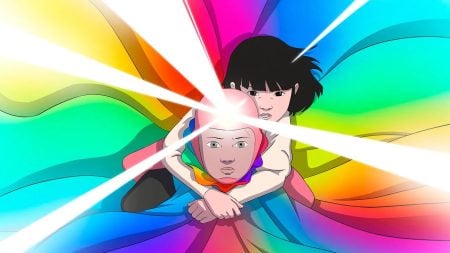If you used to think that school anime with cute aliens are usually light and easy to watch, Takopi’s Original Sin will crush that expectation right from the first episode. Adapted from Taizan5’s two-volume web manga, the Takopi’s Original Sin ONA has only six episodes but packs in school bullying, domestic abuse, guilt, time loops and an ending that is both bitter and haunting. This article gives a quick overview of the setup, then looks at the characters, themes and the anime’s ending in more detail. There are heavy spoilers through the entire piece, so it is best if you finish the show before reading further.
What makes Takopi’s Original Sin so hard to forget is not some cool plot twist, it is how the story uses small, physically weak children who are crushed by the choices of adults and by the apathy of everyone around them. The cute alien Takopi is not the main character in the usual sense. He is more like a catalyst that brings all the cracks in the kids’ minds to the surface. To really understand the ending, you first need to look at how the anime builds this warped world.
Quick overview: from a two-volume manga to a six-episode ONA
Takopi’s Original Sin begins with a scene that looks harmless at first. Takopi, a small octopus-shaped creature from the Happy Planet, falls to Earth with a mission to bring happiness to everyone by using “Happy gadgets”. He meets Shizuka Kuze, a grade school girl who has lost her smile because of bullying at school and neglect at home. Takopi believes he can fix everything just by using gadgets, but every time he intervenes, he pushes the situation into a new round of tragedy.
The anime keeps almost all of the core plot from the manga, but adds many small details in facial expressions, sound design, voice acting and a few scenes that shift the point of view toward Marina and Naoki. The six short episodes move at a tight pace, almost every episode has at least one scene that is very hard to digest. There is no “relaxing” episode. Even moments that seem cute carry a sense that something terrible is coming. If the manga shocked readers with how cruel it can be, the anime pushes the emotional impact even further through long silences, cramped shots that trap characters in the frame and the choked breathing of the children.
Characters: broken children and a naive outsider
Takopi is the entry point into the story, but the anime makes it clear very quickly that he does not understand human pain at all. He appears with big round eyes, an innocent voice and a bag full of gadgets that can wipe memories, rewind time or “make people happy”. In Takopi’s eyes, these are toys that save the day. In Shizuka’s world, they become tools that cover up consequences and then create new forms of disaster. Each time Takopi “fixes” a mistake by going back in time, the anime shows that the psychological wounds are still there and often even deeper because nothing has been faced honestly.
Shizuka Kuze sits right at the center of every loop. The anime portrays her as a girl who always looks exhausted, pushed into the corner of the classroom by her classmates, then going home to live with a mother who is impulsive and selfish and mostly concerned with her own image. The scenes where Shizuka holds Takopi’s gadgets and talks about wanting to “disappear” are some of the heaviest moments in the whole series. She no longer believes in adults, and when Takopi appears with the promise that he will “make everyone happy”, Shizuka treats it as a fragile ray of hope that she can cling to, not as a real solution. The way the anime uses Shizuka’s empty eyes makes you feel that this is the face of trauma, not just a victim that the audience is supposed to pity.
Marina Kirarazaka first appears as the typical bully. She laughs at Shizuka, films her, and drags other kids into it. However, when the anime slowly reveals Marina’s home life, the audience sees a child who lives in an atmosphere filled with emotional violence and a lack of real care. Marina bullies Shizuka because it is the only way she feels a sense of control, even if that power is twisted. The scenes where Marina panics and breaks down in later loops show that she is not just a villain, she is another victim of the adults around her.
Naoki Azuma occupies the middle ground. He does not actively torment Shizuka like Marina does, but the anime often shows Naoki witnessing the bullying, understanding that it is wrong and staying silent because he fears being targeted himself. As the story progresses, Naoki is dragged into decisions that are far beyond what a child should handle, from hiding what happened to helping deal with the consequences of serious incidents. His hesitation, silence and later guilt feel very close to the viewer, because many people have had that mindset of “I know this is wrong but I am afraid to act” at some point in life.
The anime sharpens the feeling that “everything is wrong, yet it is hard to pin all the blame on a single child”. The emotional weight is not placed on one character only, it lies in how all four children respond to the violent environment around them. The pain of Takopi’s Original Sin comes from the fact that the deeper you dig into Takopi’s Original Sin characters, the harder it is to label anyone as purely evil or purely good. You only see a circle of hurt people who keep hurting each other.
Core themes: violence, loops of guilt and adult responsibility
Takopi’s Original Sin talks about school bullying, but it does not stop at the classroom. Each child brings violence from somewhere else into school. Shizuka is abandoned by her mother and treated as an obstacle to the woman’s new life. Marina lives in a house filled with tension, where she never receives proper guidance. Naoki grows up with unspoken messages like “do not cause trouble” and “staying quiet keeps you safe”. When these children meet, the classroom turns into a place where everyone’s pain is dumped onto the weakest person.
The time loop is a visual way to show the idea of a “loop of guilt”. Each time Takopi resets, the anime makes it clear that going back does not erase responsibility. The characters still carry their selfish desires, fears and old wounds that have never been addressed. Takopi’s gadgets are similar to avoidance in real life, from pretending that something ugly never happened to shifting blame in circles. The show asks directly if the final result can ever truly change if no one is willing to face the root of the problem.
Another theme is adult responsibility. Adults in Takopi’s Original Sin rarely appear clearly on screen, but the consequences they leave behind are visible in every frame. Parents are absent or harmful, teachers have no grasp of what is really happening, the school system treats bullying as childish mischief. The anime does not dump everything on one specific adult, it creates a sense that the entire system has abandoned these children and forced them to handle crises that adults should be taking on.
The ending of Takopi’s Original Sin anime: summary and explanation
Near the end, after many accidents, deaths and loops, the story reaches a point where Takopi has to face his own “original sin”. He realizes that every time he tries to fix things with gadgets, he only shifts the pain into a different shape and often makes it worse. While he keeps saying “Takopi only wants everyone to be happy”, the loops prove that he never truly understood what any of them wanted.
The anime leads to an ending where instead of resetting again, Takopi chooses another path. He accepts that some things cannot be fixed through technology or magic and decides to pay the price himself in order to atone for the chain of mistakes. The result is a new timeline where the worst tragedies do not happen the way they did before. Shizuka and Marina are no longer tied to the same extreme events from previous loops, and their relationship, although still imperfect, has a chance to grow on the basis of understanding rather than violence. Naoki is not dragged as deeply into the cycle of hiding and guilt as he was earlier.
Even so, this is not a fairy-tale happy ending. Pain, memories and consequences still exist in some form. The anime intentionally keeps part of the new timeline ambiguous. The viewer does not see a completely clean world, only the sense that the worst loop has been broken. The message sits right there. The story does not say that sacrifice automatically makes everything fine, it suggests that breaking a loop of guilt always requires a price and that a better outcome does not mean a world without scars.
Seen through the lens of its themes, Takopi’s Original Sin feels like an accusation against the idea that “starting over fixes everything”. The show points out that if people, especially the adults around these kids, refuse to change their behavior, then any magical reset is meaningless. Takopi’s acceptance of responsibility and his choice to leave the loop show that he finally understands that happiness is not something you can plaster onto others from the outside. It has to begin with facing reality.
Conclusion: why a six-episode ONA leaves such a long shadow
Takopi’s Original Sin is a rare example of a very short story that still leaves a long-lasting impression when it uses its characters and themes correctly. The anime has very few action scenes. It does not show off flashy supernatural powers. Instead, it stays with very ordinary spaces: school hallways, cramped apartments and quiet playground corners. In these everyday locations, verbal abuse, looks, indifference and small choices are already enough to create a tragedy that hits as hard as a horror film.
The hardest thing to swallow is that Takopi’s Original Sin never gives the viewer a safe distance from which to judge. You might hate Marina and then feel sorry for her, blame Naoki and then understand him, rage at Shizuka’s mother and then think about real adults who are also lost and overwhelmed. The ending is “explained” not to comfort the audience, but to raise a question. In that position, how much better would you really do. This feeling, the sense that you are forced to look at yourself, is why many people do not want to rewatch the anime even though they still call it one of the most memorable psychological titles about violence and responsibility.
If you are looking for an anime that gives you more than just entertainment, Takopi’s Original Sin is a tough but worthwhile choice. It does not offer relief. It leaves a weight on your chest and pushes you to think about how society treats children, about loops of guilt and about what it really means to “make someone happy”. That is why, even with only a few short episodes, this anime keeps coming up whenever people discuss heavy psychological series.

Elara is a dynamic writer and blogger who specializes in pop culture and movie reviews. With a background in film studies and journalism, she combines her deep knowledge of the entertainment industry with a sharp, insightful writing style that keeps readers coming back for more.




![‘Jay Kelly’ Review – Noah Baumbach Makes A Case For The Magic Of Movie Stardom [NYFF 2025] ‘Jay Kelly’ Review – Noah Baumbach Makes A Case For The Magic Of Movie Stardom [NYFF 2025]](https://cdn.geekvibesnation.com/wp-media-folder-geek-vibes-nation/wp-content/uploads/2025/11/Jay-Kelly-JKELLY_20240523_15320_C2_R-300x180.jpg)

